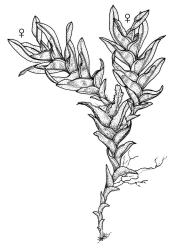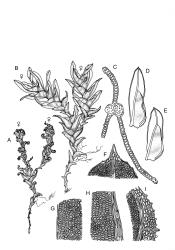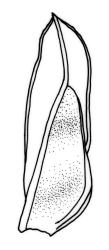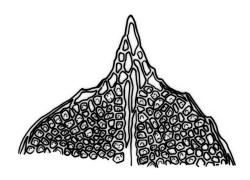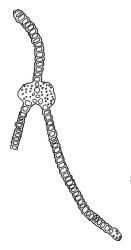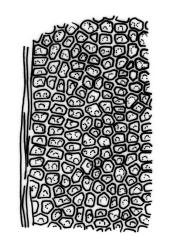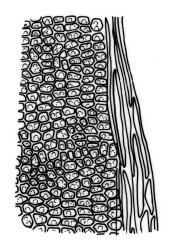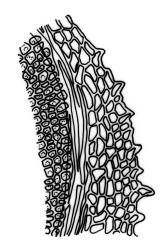Plants 4–6 mm, yellow-green to brown-green, densely gregarious. Stems occasionally branched, with rhizoids at base only. Leaves in 6–15 pairs, patent to squarrose-recurved, decurved when moist, inrolled at the apex towards the substrate when dry, oblong, 1.0–1.6 × 0.3–0.5 mm; apex obtuse and apiculate; laminae unistratose; vaginant laminae ⅔–¾ leaf length, open, gaping; dorsal lamina failing above or reaching the leaf insertion, tapered to its base; margins irregularly serrulate at leaf apex, entire or occasionally irregularly serrate in proximal region of vaginant laminae; marginal cells distinct in several rows, thick-walled, prosenchymatous, forming a pluristratose border, inconspicuous on dorsal and apical laminae, conspicuous on vaginant laminae, becoming intramarginal towards leaf base; cells of apical and dorsal laminae pentagonal to hexagonal, smooth to weakly multipapillose, strongly bulging, obscure, with moderately thick walls, (4.0–)5.0–7.5(–9.0) × (4.0–)4.5–7.0(–7.5). Costa percurrent, bryoides-type in cross-section.
Dioicous. Perichaetia terminal; perichaetial leaves longer than vegetative; occasional archegonia in leaf axils. Perigonia and capsules unknown in N.Z. Peristome bryoides-type (in Australian material).
Wilson 1859, pl. 171, fig. 6 (as F. vittatus); Scott & Stone 1976, pls 7–9 (pro parte, as F. vittatus); Catcheside 1980, fig. 17 (as F. vittatus); Magill 1981, fig. 10, 9–16 (as F. rufescens); Beever et al. 2002, p. 44, figs 1–6; Stone & Catcheside 2012.
In the field, when dry, the broad, inrolled leaves of F. megalotis subsp. megalotis, with costae and vaginant lamina borders prominent, are distinctive. The combination of a bluntly and irregularly toothed vaginant lamina margin with an intramarginal border, when present, will separate it from all other N.Z. species. The nature of the leaf apex, obtuse and apiculate, with the shortly excurrent costa fusing with very narrow leaf borders, is also a useful character. Ornamentation of the laminal cells is never conspicuous, and they have been aptly described by Bruggeman-Nannenga (2013) as being "with strongly lenticularly or molarlike thickened walls".
Fissidens megalotis subsp. helictocaulos (Müll.Hal.) Brugg.-Nann. is an African subspecies, differing in its less strongly crispate leaves, borders that are intramarginal by fewer cell rows, entire vaginant laminal margins, and vaginant laminae slightly, but not completely, open (Bruggeman-Nannenga 2013).
K; NI: N Auckland, including offshore islands (GB, RT), S Auckland, Gisborne, Hawke’s Bay, Wellington; SI: Nelson, Marlborough, Canterbury, Otago; Ch.
Southern xeric. Tasmania*, mainland Australia*, South Africa*.
On soil or rock in exposed sites, and more common in the drier, eastern regions of both North and South Is. Fissidens megalotis subsp. megalotis is probably the most xerophilous of the N.Z. species of Fissidens. Associated mosses include members of the family Pottiaceae, all characteristically somewhat xerophilous, such as: Barbula convoluta, B. unguiculata, Didymodon australasiae, Pseudocrossidium hornschuchianum, Syntrichia antarctica, Tortula muralis, and Weissia controversa. Other species of Fissidens, such as F. asplenioides, F. curvatus var. curvatus, F. leptocladus, and F. taxifolius, as well as the ruderals Bryum dichotomum and Ceratodon purpureus, are recorded as associates of F. megalotis subsp. megalotis.
Recorded from near sea level to 600 m (The Crater, near Middlemarch, Otago L.D.).



